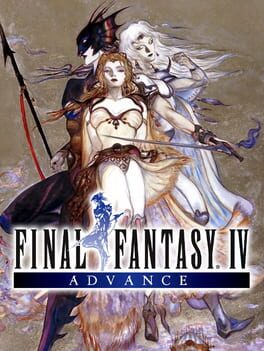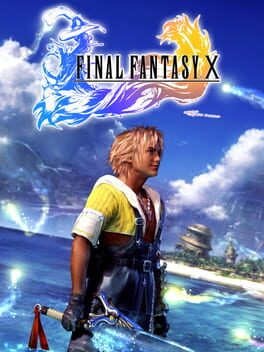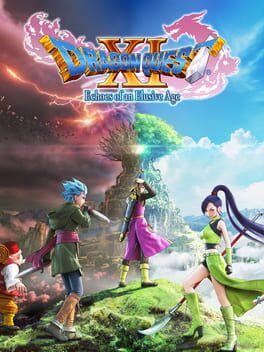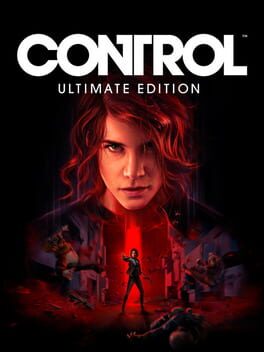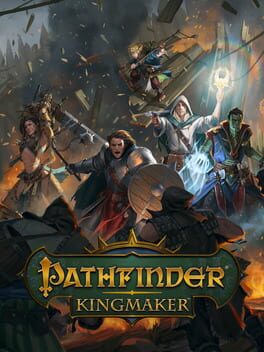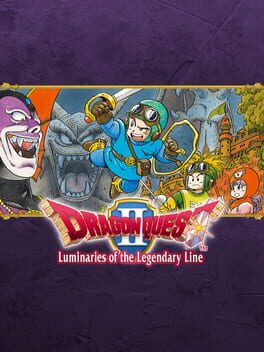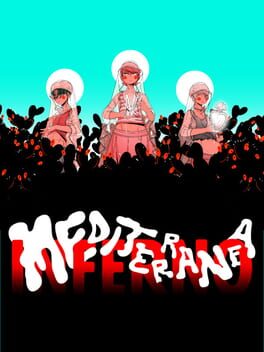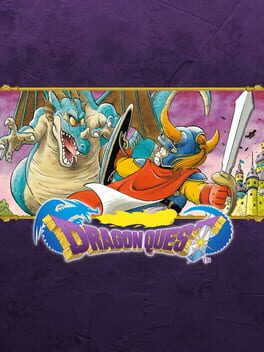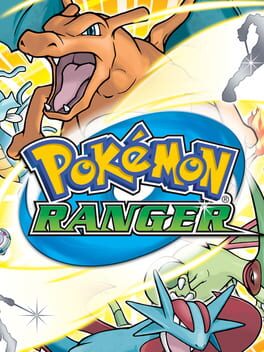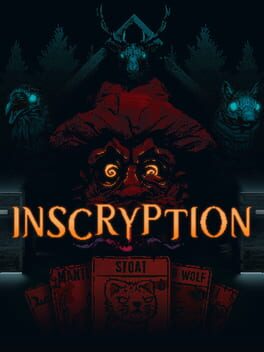el_hermano
Bio
In 1997, a team of scientists managed to create the ultimate lifeform. 25 years later, it is ready to simply play videogames til its timely demise. This is the story of how that ultimate lifeform WILL start dozens of videogames and WILL only manage to finish, like, 3 of those.
In 1997, a team of scientists managed to create the ultimate lifeform. 25 years later, it is ready to simply play videogames til its timely demise. This is the story of how that ultimate lifeform WILL start dozens of videogames and WILL only manage to finish, like, 3 of those.
Badges

GOTY '23
Participated in the 2023 Game of the Year Event

1 Years of Service
Being part of the Backloggd community for 1 year

Popular
Gained 15+ followers

Liked
Gained 10+ total review likes

On Schedule
Journaled games once a day for a week straight

Best Friends
Become mutual friends with at least 3 others

Noticed
Gained 3+ followers
Favorite Games
051
Total Games Played
008
Played in 2024
042
Games Backloggd
Recently Played See More
Recently Reviewed See More
The template laid down by Dragon Quest remains undefeated in the genre of Japanese RPGs. There is a remarkable level of care that has gone into making sure that there is an appropriate level of friction between the adventure of the player and the objective of the game.
The game is fairly small and "spherical". By that I mean that there is a centerpoint that is Radatome Castle, and then there is the rest of the map that is equally long in both directions, east and west. This allows the game to justify (a poor word to choose considering they had legitimate technical limitations, but it gets the point across) making saving exclusive in Radatome Castle, at King Lars's. No distance then is great enough to be too tedious to traverse. Planning your travels is easy as well, considering you can purchase Wings of the Chimera early in the game to teleport back to Radatome Castle, and later on you can access the Return spell to use in place of the Wings. It also bears reminding that death doesn't bring any particular penalty other than interrupting your exploration and bringing you back to the centerpoint, which is farily forgiving given what was said for distances. The game is also crystal clear. The combination of the game box manual along with the initial indications from King Lars give all the tools you need to understand and clear the game. People in towns rarely gives you cryptic messages.
Ultimately, the game is lenient and fair with its player. And this lenient structure allows the game maker to be more thoughtful of the points where is wants to increase friction, rather than just make the game all friction. There are of course parts of the experience that suffer because of this. Battles become a matter of simple attacking arithmetic with no further complexity involved whatsoever, besides the Sleep spell that can come in handy in certain parts of the game where the dps race does not particularly work in the player's favour. This already highlights how random battles have been a particular point of strain in the genre since the beginning, which few have ever really dealt with correctly. Moreover the inherent small size of the world makes for a short experience, alothough for sure not unpleasant (I think it is fair to remember I have played the SNES remake which has some quality of life improvements that might have shaved off almost an hour of game time). And in particular the endgame feels a little anti-climactic, mostly because of its lack of active narrative and letting the player decide for themself the moment of ending the game.
In the end, this game embodies a level of playfulness that is perfectly encapsulated by Akira Toriyama's artistic design for the series at this particular moment in the author's artistic development. Simple, rotund, clear, uncomplicated.
The game is fairly small and "spherical". By that I mean that there is a centerpoint that is Radatome Castle, and then there is the rest of the map that is equally long in both directions, east and west. This allows the game to justify (a poor word to choose considering they had legitimate technical limitations, but it gets the point across) making saving exclusive in Radatome Castle, at King Lars's. No distance then is great enough to be too tedious to traverse. Planning your travels is easy as well, considering you can purchase Wings of the Chimera early in the game to teleport back to Radatome Castle, and later on you can access the Return spell to use in place of the Wings. It also bears reminding that death doesn't bring any particular penalty other than interrupting your exploration and bringing you back to the centerpoint, which is farily forgiving given what was said for distances. The game is also crystal clear. The combination of the game box manual along with the initial indications from King Lars give all the tools you need to understand and clear the game. People in towns rarely gives you cryptic messages.
Ultimately, the game is lenient and fair with its player. And this lenient structure allows the game maker to be more thoughtful of the points where is wants to increase friction, rather than just make the game all friction. There are of course parts of the experience that suffer because of this. Battles become a matter of simple attacking arithmetic with no further complexity involved whatsoever, besides the Sleep spell that can come in handy in certain parts of the game where the dps race does not particularly work in the player's favour. This already highlights how random battles have been a particular point of strain in the genre since the beginning, which few have ever really dealt with correctly. Moreover the inherent small size of the world makes for a short experience, alothough for sure not unpleasant (I think it is fair to remember I have played the SNES remake which has some quality of life improvements that might have shaved off almost an hour of game time). And in particular the endgame feels a little anti-climactic, mostly because of its lack of active narrative and letting the player decide for themself the moment of ending the game.
In the end, this game embodies a level of playfulness that is perfectly encapsulated by Akira Toriyama's artistic design for the series at this particular moment in the author's artistic development. Simple, rotund, clear, uncomplicated.
Cute attempt at showing off the prowess of the Nintendo DS as a gaming device, with some smoke and mirrors to hide its limitations. The core of the game revolves around the adaptation of the Pokémon mainline gameplay loop in order to accomodate the introduction of the touch screen and stylus. The gameplay loop revolves around monster capturing, an offshoot of monster collecting from the main series. Pokémon are captured with the only intention of temporarily using their abilities to remove obstacles and then releasing them back to freedom.
What Ranger shines in is putting Pokémon at the center of the game. I think the mainline games have always made some mistakes in how they create an experience centered around Pokèmons, for example the exclusivity of starters leading to them having way too much staying power on your team and thus heavily affecting team composition in absence of incentives to rotate team members, or how Pokémon are observable only in tall grass. These things have been worked on slowly through generations, but Ranger took and reworked them immediately in a pleasant and rational way. Pokémon are now visible on screen during travels and a capture starts on touch; no more tall grass. The gameplay only involves player vs pokemon through the stylus, pokémon do not and cannot fight each other here. Pokémon are modelled and animated through splendid sprite work, and all have curious and neat individual animations. Pokémon are also coherent with their descriptions and stated behaviours and thus feel like proper and diverse living beings. Always a big fan of letting creatures be creatures.
In general though this level of precision in Pokémon interaction comes at the expense of most other things affecting the game. This is a small game. The main story can be finished in roughly 10 hours, while total completion of the regional pokédex might take 15 hours. The world of the game in particular is quite small. There are just 4 cities and only an handful of other locations. There are little tricks that make the game seem slightly larger than it is: for example, the camera is oddly centered on and close by the player character to create an illusory sense of breatdh of environment. Although cities are just an handful of houses and exploration involves three or four screens of walking at best, this give the illusion that exploration takes just a couple seconds longer than expected and hides, best it can, the map's general weakness. Pokémon capture sessions also take place in rather uninspired stages, which also feel comically small because the Pokémon you are trying to capture can and will run past the borders of the screen, where you cannot reach them. From a gameplay perspective, this is a fine concession to the cpu in order to even the odds against your capture possibilities, but from an experience perspective, this all leads to the game being played as if looking through a microscope. That same microscope is used for the plot of the game, a sufficiently competent work decorated with mildly entertaining and goofy characters, but nothing to write home about.
Post Edit: One thing I completely forgot to mention with respect to gameplay choices and tricks that try to manipulate your perception of the breatdh of the game: you cannot run in this game. This is small, but it's also been seriously bugging me during the whole 10 hours of gameplay I had. Running and faster-than-walking travel is somewhat of a staple in Pokémon games, through the running shoes and the bicycles. Here you get nothing of the sort. Although your walking speed is solid and brisk, it seems tailored to the small enviornments I've talked about. I don't know if I should have a legitimate expectation of being able to run in any RPG Pokémon game (take for example the Mystery Dungeon games), but I can't deny I had a few moments where I really wished I was faster. And in relation to the little world of the game, I realize if I were going any faster the game would undeniably become excessively short and unsatisftying.
What Ranger shines in is putting Pokémon at the center of the game. I think the mainline games have always made some mistakes in how they create an experience centered around Pokèmons, for example the exclusivity of starters leading to them having way too much staying power on your team and thus heavily affecting team composition in absence of incentives to rotate team members, or how Pokémon are observable only in tall grass. These things have been worked on slowly through generations, but Ranger took and reworked them immediately in a pleasant and rational way. Pokémon are now visible on screen during travels and a capture starts on touch; no more tall grass. The gameplay only involves player vs pokemon through the stylus, pokémon do not and cannot fight each other here. Pokémon are modelled and animated through splendid sprite work, and all have curious and neat individual animations. Pokémon are also coherent with their descriptions and stated behaviours and thus feel like proper and diverse living beings. Always a big fan of letting creatures be creatures.
In general though this level of precision in Pokémon interaction comes at the expense of most other things affecting the game. This is a small game. The main story can be finished in roughly 10 hours, while total completion of the regional pokédex might take 15 hours. The world of the game in particular is quite small. There are just 4 cities and only an handful of other locations. There are little tricks that make the game seem slightly larger than it is: for example, the camera is oddly centered on and close by the player character to create an illusory sense of breatdh of environment. Although cities are just an handful of houses and exploration involves three or four screens of walking at best, this give the illusion that exploration takes just a couple seconds longer than expected and hides, best it can, the map's general weakness. Pokémon capture sessions also take place in rather uninspired stages, which also feel comically small because the Pokémon you are trying to capture can and will run past the borders of the screen, where you cannot reach them. From a gameplay perspective, this is a fine concession to the cpu in order to even the odds against your capture possibilities, but from an experience perspective, this all leads to the game being played as if looking through a microscope. That same microscope is used for the plot of the game, a sufficiently competent work decorated with mildly entertaining and goofy characters, but nothing to write home about.
Post Edit: One thing I completely forgot to mention with respect to gameplay choices and tricks that try to manipulate your perception of the breatdh of the game: you cannot run in this game. This is small, but it's also been seriously bugging me during the whole 10 hours of gameplay I had. Running and faster-than-walking travel is somewhat of a staple in Pokémon games, through the running shoes and the bicycles. Here you get nothing of the sort. Although your walking speed is solid and brisk, it seems tailored to the small enviornments I've talked about. I don't know if I should have a legitimate expectation of being able to run in any RPG Pokémon game (take for example the Mystery Dungeon games), but I can't deny I had a few moments where I really wished I was faster. And in relation to the little world of the game, I realize if I were going any faster the game would undeniably become excessively short and unsatisftying.
i feel i am at a point in my life where the creepypasta-influenced narrative does not cut it for me much. which is strange, because the first act of the game stands on its own two legs perfectly fine, regardless of what happens in the rest of the game when the creepypasta narrative elements are introduced. i guess this is the danger of building a game around a big reveal and then not being able to deliver.
besides that, the videogame has a sort of progression curve built around its narrative, that dictates your progression in the card game. i felt like i could never win at the card game in certain moments unless i had progressed enough in the narrative as the videogame intended. at a certain point, i could feel like the only way to approach the game was through a sort of calculated dps-maximizing strategy, where you avoid engaging with enemy monsters, or at best try to remove threats from the board if you end up facing a big beater (like a shark or a bear) that favours the opponent's dps excessively. this kind of structure could be felt in all different versions of the card game you end up playing. this would mean that the enemy could dial up their own dps as much as they wanted, considering they do not seem to have resources constraints of any kind.
i'm not sure i agree with this kind of guided structure, as it makes the card game less relevant overall to the whole videogame. or maybe i'm just poor at card games and couldn't build a deck strong enough to win certain battles earlier than intended? dunno, but after all this i don't feel like spending more time in the game getting trophies or playing through kaycee's mod.
besides that, the videogame has a sort of progression curve built around its narrative, that dictates your progression in the card game. i felt like i could never win at the card game in certain moments unless i had progressed enough in the narrative as the videogame intended. at a certain point, i could feel like the only way to approach the game was through a sort of calculated dps-maximizing strategy, where you avoid engaging with enemy monsters, or at best try to remove threats from the board if you end up facing a big beater (like a shark or a bear) that favours the opponent's dps excessively. this kind of structure could be felt in all different versions of the card game you end up playing. this would mean that the enemy could dial up their own dps as much as they wanted, considering they do not seem to have resources constraints of any kind.
i'm not sure i agree with this kind of guided structure, as it makes the card game less relevant overall to the whole videogame. or maybe i'm just poor at card games and couldn't build a deck strong enough to win certain battles earlier than intended? dunno, but after all this i don't feel like spending more time in the game getting trophies or playing through kaycee's mod.
